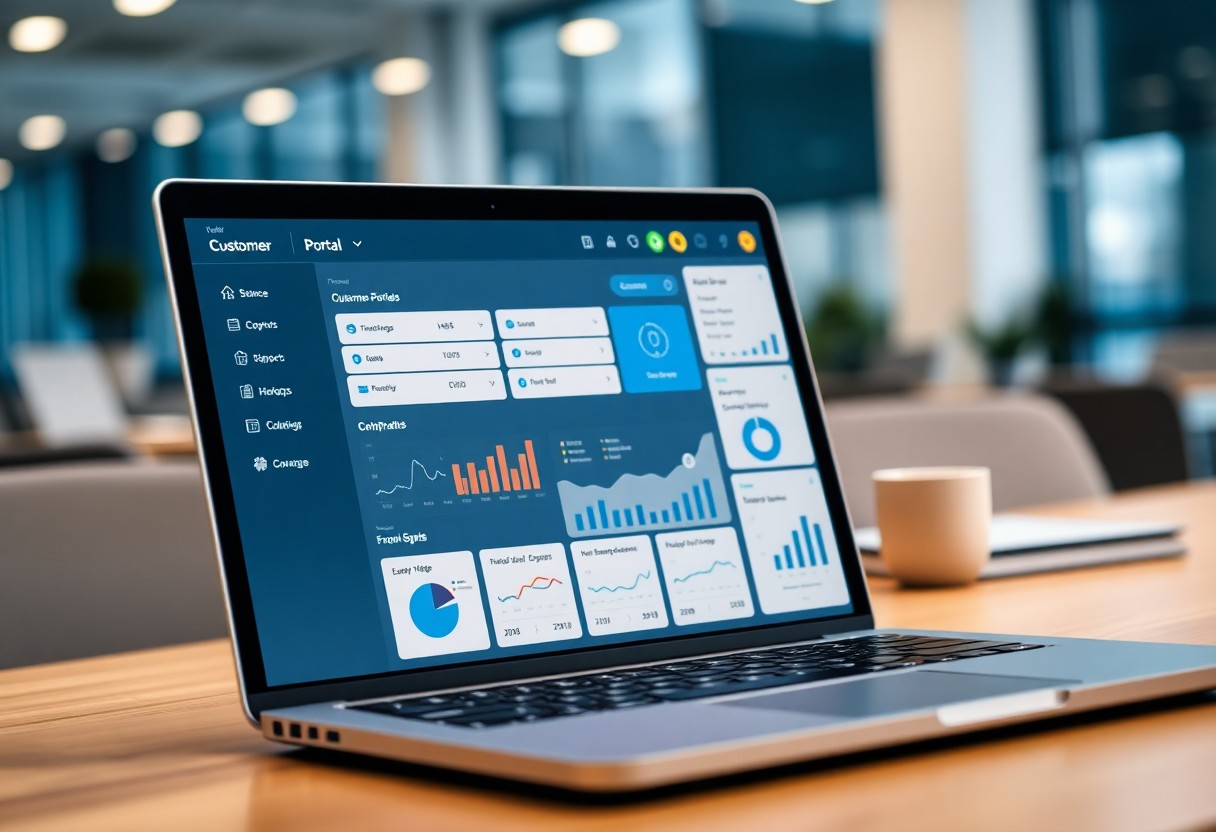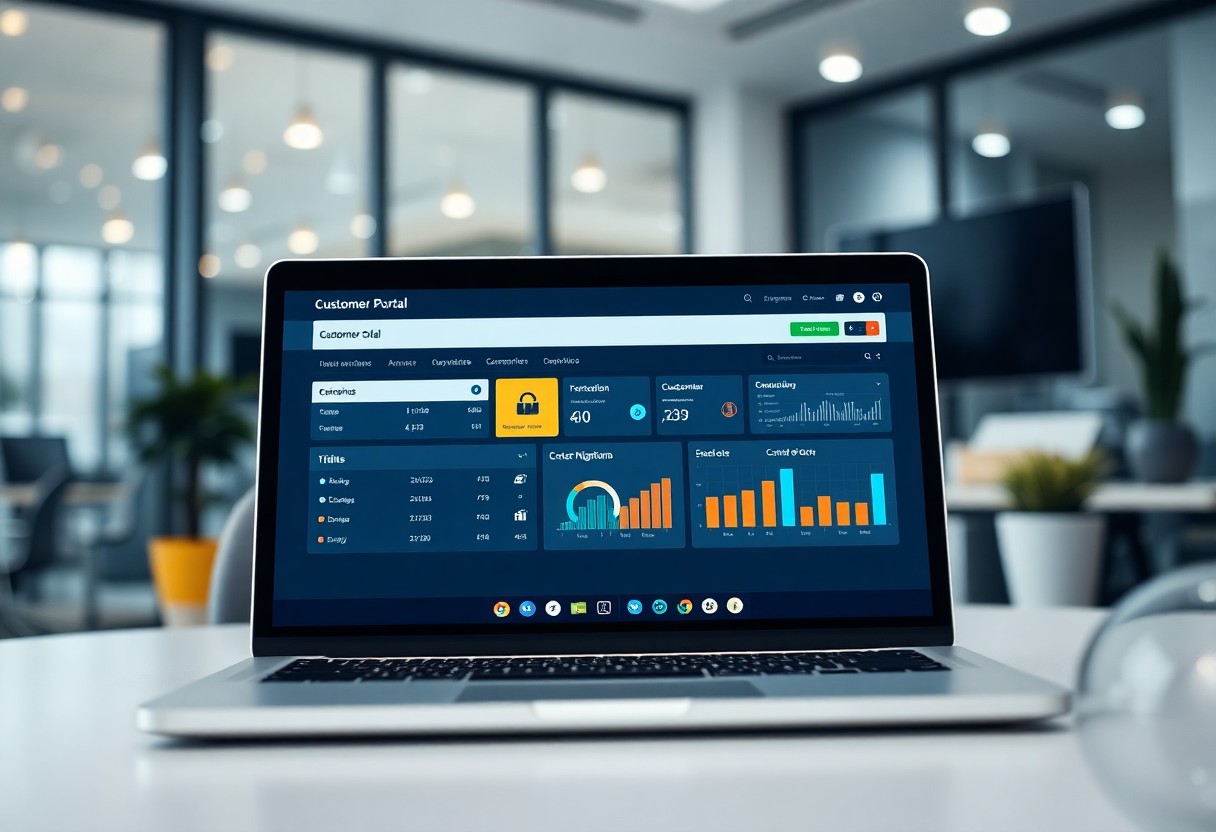You can significantly improve your business’s success by building a customer portal that not only meets your users’ needs but also enhances their experience. An effective customer portal allows you to streamline communication, provide vital resources, and foster a sense of community among your clients. By focusing on user-friendly interface design and personalized content delivery, you can create a space where customers feel valued. This approach will ultimately lead to increased retention rates and build lasting relationships that contribute positively to your overall brand reputation.
Understanding Customer Portals
Your understanding of customer portals is vital when building one that enhances user experience and improves retention. A customer portal is a secure online platform that allows customers to access information and services related to their account, products, or services provided by a business. The primary purpose of customer portals is to facilitate interactions between your company and customers, leading to improved communication and streamlined processes.
Definition and Purpose of Customer Portals
To effectively support your customers, a customer portal serves as a centralized hub where they can manage their accounts, access valuable resources, and receive personalized support. By utilizing a portal, you can enhance customer satisfaction by providing quick and convenient access to the information they need.
Importance of User Experience in Customer Portals
Before venturing into the technical aspects of building your customer portal, it’s important to focus on the user experience (UX). A well-designed UX ensures that your customers can navigate the portal efficiently, find vital information, and engage with your services without confusion.
Also, an optimal user experience can significantly influence your customer’s perception of your brand. When your portal is intuitive, responsive, and tailored to their needs, it fosters a sense of trust and loyalty. A positive UX reduces frustrations, encourages regular usage, and gives customers a reason to return, which is vital for long-term success.
The Role of Customer Portals in Retention Strategies
Customer portals play a significant role in your retention strategies by providing a platform for continuous engagement. By offering features such as self-service options, personalized recommendations, and prompt support, you enhance the overall customer journey, making it more likely they will stay loyal to your brand.
But successfully leveraging customer portals for retention requires attention to detail and an understanding of your customers’ needs. If your portal offers valuable features and an exceptional user experience, it significantly contributes to reducing churn rates. Providing a space where users feel valued and understood will strengthen their connection to your brand, ultimately driving retention and loyalty.

Key Features of an Effective Customer Portal
Now, to build a customer portal that truly enhances user experience and boosts retention, you must consider several key features. A well-designed portal should include:
- User-Friendly Interface: Intuitive navigation and clean design are imperative.
- Customization and Personalization Options: Tailor the experience to meet individual customer needs.
- Integration with Existing Systems: Seamlessly connect your portal to CRM, ERP, and other platforms.
- Mobile Accessibility and Responsive Design: Ensure users can access the portal on any device.
- Secure Access and Authentication: Prioritize customer data protection through secure login systems.
- Comprehensive Self-Service Features: Allow users to resolve issues on their own, improving satisfaction.
- Real-Time Support and Communication Tools: Offer chat functionalities, FAQs, and support tickets for immediate assistance.
- Analytics and Reporting Tools: Enable tracking of user behavior and portal performance to drive improvements.
This thoughtful combination of features will create a robust customer portal that meets user expectations.
For further insights, explore our guide on Customer Portal Best Practices to Guarantee Your Success.
User-Friendly Interface
At the core of a successful customer portal is a user-friendly interface. You want to ensure that users can easily navigate through the portal without confusion. Simplified layouts, clear labels, and logical pathways lead to an engaging experience that encourages users to explore and utilize the resources available.
Customization and Personalization Options
Along with a user-friendly interface, providing customization and personalization options can set your portal apart. By allowing users to modify their dashboard or select the information that matters most to them, you enhance their engagement and satisfaction.
With these options, users can receive tailored notifications and access features that align with their interests. This leads to a more relevant and compelling experience, ultimately driving customer loyalty and retention.
Integration with Existing Systems
Existing systems play a vital role in the functionality of your customer portal. You should ensure that your portal can integrate smoothly with current technologies and databases. This provides a more cohesive experience for users, allowing them to access all relevant information in one place.
Effective integration not only streamlines operations but also makes it easier for you to manage customer interactions. By consolidating data from different sources, you can offer comprehensive support and insights, enhancing the overall value of your portal.
Mobile Accessibility and Responsive Design
Systems today demand mobile accessibility and a responsive design. You must ensure that your customer portal is optimized for mobile devices, allowing users to access information on-the-go. A mobile-friendly design enhances usability and increases engagement as users can easily interact with your portal anytime, anywhere.
Mobile adaptability means you can cater to a wide range of users who prefer using smartphones or tablets. By investing in a responsive design, you significantly improve user satisfaction and retain more customers.
Designing the Customer Portal
Despite numerous technological advancements, the effectiveness of a customer portal ultimately relies on how well it meets the specific needs of its users. A well-thought-out design will make your portal intuitive and engaging, enhancing user experience and fostering customer loyalty.
Conducting User Research and Needs Assessment
With each user group having unique requirements, it’s important to conduct thorough research. Engage with your target audience through surveys, interviews, and focus groups to discover their expectations and pain points. This will provide you with valuable insights to inform your design decisions.
Mapping Customer Journeys
Along with understanding user needs, mapping customer journeys allows you to visualize how users will interact with your portal. This process highlights key touchpoints and areas where you can improve user experience by addressing barriers and simplifying processes.
Mapping your customer journeys involves outlining the sequential steps users take when utilizing your service. Consider their emotions at each touchpoint, and identify any potential frustrations they may encounter. This will enable you to create a more refined and responsive customer portal tailored to their journey.
Prototyping and Wireframing
Around your research findings, create wireframes and prototypes that reflect the desired user experience. This conceptual representation will help you visualize the layout, functionality, and navigation of your portal, ensuring that you’re on the right track before development begins.
Needs assessment and brainstorming sessions should guide your prototyping phase. Develop wireframes that showcase necessary features and prioritize functionality. This tool helps you make informed decisions about the overall structure, allowing you to assess how each element supports user needs and enhances engagement.
Iterative Design and Testing
Between your design stages, you must incorporate feedback loops to continuously refine your portal. Testing with real users will reveal what works effectively and what requires adjustment, enabling you to make data-driven improvements.
Customer feedback is invaluable during this iterative process. Engage users in testing phases to gather insights on usability, functionality, and aesthetics. By actively involving your user base, you can make informed adaptations to your portal, ensuring it aligns with user expectations and ultimately drives retention.
Implementing the Customer Portal
Unlike traditional methods of customer interaction, implementing a customer portal requires careful consideration of various technological and operational elements that can significantly impact user experience.
Choosing the Right Technology Stack
Against the backdrop of a rapidly evolving digital landscape, selecting the right technology stack is imperative. You should consider options that offer scalability, integration capabilities, and user-friendliness to support your business needs effectively.
Developing a Solid Data Security Plan
The need for robust data security cannot be overstated. You must put in place measures that protect customer information from breaches and unauthorized access to ensure trust and compliance with regulations.
Consequently, implementing a solid data security plan involves several layers. This means utilizing encryption for data in transit and at rest, conducting regular security audits, and offering multi-factor authentication. Prioritizing these practices will help safeguard sensitive information and uphold your brand reputation.
Training and Onboarding Strategies for Users
About facilitating a seamless transition to your customer portal, effective training and onboarding strategies are key. You should provide step-by-step guidance to ensure users can navigate the portal without frustration.
In fact, creating tailored training sessions, whether through webinars, tutorials, or dedicated help centers, empowers users. When they feel confident using the portal, it enhances their experience and encourages higher engagement levels with your offerings.
Continuous Improvement and Updates
Plan for ongoing enhancements to your customer portal. Regularly reviewing user feedback and data analytics will help identify areas of improvement and ensure that your portal remains relevant and functional.
Continuous updates signal to your customers that you value their experience. By iterating on features based on user interactions and requests, you demonstrate your commitment to excellence and adapt to changing market demands, thus fostering lasting customer loyalty.

Measuring Success and User Engagement
Many organizations overlook the importance of measuring success and user engagement when building a customer portal. Understanding how users interact with your platform will help you enhance their experience and improve retention rates over time.
Key Performance Indicators (KPIs) for Customer Portals
Customer satisfaction and portal usage metrics are important KPIs to monitor. By tracking user activity, transaction completion rates, and support ticket resolution times, you can evaluate the effectiveness of your portal and identify areas for improvement.
Gathering User Feedback and Insights
Beside quantitative metrics, gathering user feedback is vital in understanding their needs. Surveys, interviews, and feedback forms allow you to hear directly from users about their experience, helping you pinpoint what works and what does not.
Measuring user feedback can provide invaluable insights into your portal’s strengths and weaknesses. By actively encouraging users to share their thoughts and concerns, you not only enhance engagement but also foster a sense of community. This ongoing dialogue allows you to adapt your platform based on real user needs and expectations, ultimately leading to heightened satisfaction.
Analyzing User Behavior with Analytics Tools
Around every successful customer portal is a solid analytics framework. Utilizing tools like Google Analytics or Mixpanel lets you track user flows, click paths, and conversion rates, allowing for pointed adjustments to your portal.
With the right analytics tools, you can gain deep insights into how users interact with your portal. By examining engagement metrics, such as session duration and bounce rates, you can identify patterns and behaviors that indicate areas for enhancement. This data-driven approach empowers you to make informed decisions, ensuring that your customer portal evolves in line with user expectations and preferences.

Case Studies and Best Practices
All successful businesses know that enhancing user experience is key to boosting retention. Below are remarkable case studies that illustrate the impact of effective customer portals:
- Company A achieved a 35% increase in customer retention rates after implementing a user-friendly portal that streamlined support requests and feedback submissions.
- Company B reported a 50% reduction in customer service response time due to intuitive self-service options in their portal, leading to higher customer satisfaction scores.
- Company C saw a 40% increase in user engagement by incorporating personalized content into their portal, which tailored resources and recommendations based on user behavior.
- Company D experienced a 30% decrease in churn rates after allowing customers to track order statuses and deliveries through their portal, fostering greater transparency.
- Company E reported that 70% of users prefer engaging with the portal over calling customer service, validating the portal’s success in improving user interactions.
Successful Customer Portals in Different Industries
Between various industries, customer portals play a vital role in enhancing user satisfaction and driving retention. For instance, the healthcare sector has leveraged patient portals to boost engagement by 60%, while retail companies utilize loyalty program portals to encourage repeat purchases, leading to a 25% increase in customer lifetime value.
Common Pitfalls and How to Avoid Them
At times, businesses may face challenges when developing customer portals, which can hinder user experience. Issues like complex navigation, lack of personalization, and insufficient support options are often common pitfalls. To avoid them, focus on user-friendly design, incorporate personalized features, and ensure easy access to assistance.
Them are some areas where portal developers typically stumble. You should invest in thorough user research to understand your audience and their needs. Ensuring a smooth user journey through organized layouts and clear call-to-action buttons is crucial. Furthermore, involving users during the testing phase can help eliminate frustrating elements before your portal launch.
Lessons Learned from Real-World Implementations
An important aspect of creating effective customer portals is learning from real-world implementations. Analyze case studies and adapt best practices to fit your unique business context. Understanding what has worked for other businesses can guide your approach and lead to improvements in your own portal’s design.
Considering the experiences of others when building a customer portal can yield significant insights. For example, consistently revisiting user feedback allows for quick adjustments and enhancements. Also, focusing on seamless integration with other systems can optimize functionality and improve user satisfaction, ultimately driving retention and loyalty.
To wrap up
Conclusively, building a customer portal that enhances user experience and boosts retention involves a strategic approach to design and functionality. You should focus on intuitive navigation, personalized interactions, and seamless integration with existing systems. By prioritizing user feedback and continuously improving your portal, you create a valuable resource that meets your customers’ needs. Invest in user-friendly features and ensure your support systems are responsive, ultimately fostering loyalty and satisfaction in your customer base.
FAQ: How to Build a Customer Portal That Enhances User Experience and Boosts Retention
Q: What are the primary benefits of having a customer portal?
A: A customer portal provides a centralized platform for customers to access information, services, and support. Key benefits include enhanced user experience through easier navigation, personalized content, improved communication channels for support, and increased customer loyalty. This can lead to higher retention rates as users find value in the accessibility and ease of use.
Q: What features should be included in a customer portal to enhance user experience?
A: Essential features for a user-friendly customer portal include easy onboarding processes, intuitive navigation, self-service options for account management, responsive design for mobile devices, personalized dashboards, and integrated customer support (like chatbots or ticketing systems). Additionally, tools that enable users to track orders, access knowledge bases, and provide feedback can greatly enhance the experience.
Q: How can personalization within the customer portal improve retention?
A: Personalization enables the portal to cater specifically to the individual user’s preferences and needs. By leveraging data analytics and user behavior insights, you can deliver tailored content, product recommendations, and relevant notifications. This makes users feel valued and understood, significantly improving engagement and encouraging them to return to the portal frequently.
Q: What role does user feedback play in developing a customer portal?
A: User feedback is instrumental in shaping an effective customer portal. It provides insights into what users appreciate and what is lacking in their current experience. By continuously gathering and analyzing feedback through surveys, usability tests, and direct communication, businesses can make informed adjustments, ensuring the portal evolves to meet user expectations and needs.
Q: How important is mobile optimization for customer portals?
A: Mobile optimization is critical as an increasing number of users access online services via smartphones and tablets. A responsive design ensures that users can easily navigate the portal and complete tasks on any device. If a portal is not mobile-friendly, users may experience frustration, leading to decreased usage and increased likelihood of abandoning the platform.
Q: What metrics should be monitored to evaluate the success of a customer portal?
A: Key metrics to track include user engagement rates (like login frequency and time spent on the portal), customer satisfaction scores (CSAT), Net Promoter Scores (NPS), support ticket resolution times, and user retention rates. Analyzing these metrics helps assess the portal’s effectiveness in delivering value and identifying areas for improvement.
Q: How can security be ensured in a customer portal while maintaining user experience?
A: Security measures such as HTTPS encryption, secure password policies, and multi-factor authentication should be implemented without hindering user experience. Ensuring a seamless login process and clearly communicating security policies can enhance trust while allowing users to feel secure as they interact with the portal. Regular security audits and updates are also vital to protect sensitive customer information.


![10 Must-Have AI Tools for Startups & Small Businesses [2026]](https://smartgeekguide.com/wp-content/uploads/2025/10/top-10-ai-tools-for-startups-2026-xmg-360x240.jpg)






